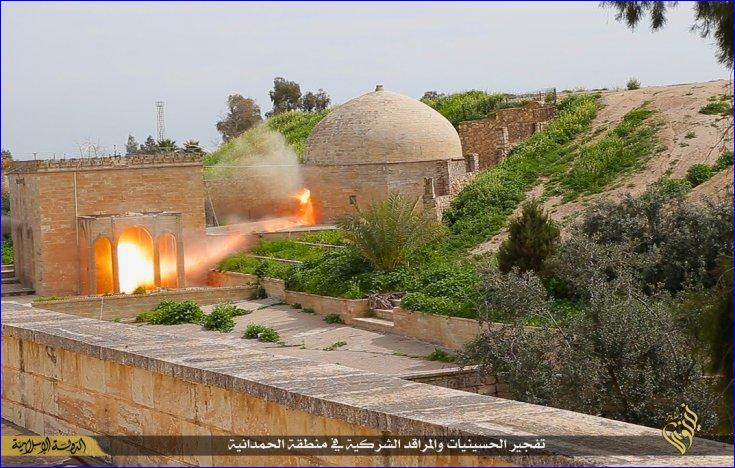


The monk's story, along with that of his four fellow monks, at their ancient Syriac Mar (Saint) Behnam Monastery in Khidr, near Mosul in Iraq, speaks to the suffering and the perseverance of those bearing witness to their faith.
On March 19, 2015, ISIS fighters blew up the tomb of Mar Behnam and Mart Sarah, completely leveling the historic monastery at which Fr. Sakat was superior. Gone were the irreplaceable architecture and artifacts. According to French scholar J.M. Fiey, "Among collections in situ of sculpture of the period of the Atabeg rulers of Mosul Mar Behnam monastery has no rival; no study of Abbasid art can pass it by without mention."
Father Sakat's story begins when a group of Islamic State militants visited the monks at the ancient monastery and benignly invited them to convert to Islam in 2014.
The invitation fell just a few days after carloads of militants roared down the road leading to the monastery, announcing through megaphones that the Islamic State was now in control. The Iraqi army had also withdrawn from a checkpoint nearby.
Related: Timeline of ISIS in Iraq
Related: Attacks on Assyrians in Syria By ISIS and Other Muslim Groups
The militants banged on the monastery doors and shouted كافر ("infidel") at the monks.
Father Sakat explained his concern for the historical treasures under his protection. Chalices and other sacramentals, as well as a collection of religious manuscripts dating from the 12th to 18th centuries written in Syriac, Greek, French and Latin, were housed there.
According to Fr. Sakat, the monks prayed to Mar Behnam, believing "we were in a blessed place," made blessed by generations of Syriac Catholic Christians who had also faced persecution.
The monks had a Muslim friend who had been providing them with updates on ISIS activities. But conditions became too dangerous for him to continue to visit them.
So Fr. Sakat attempted to take the manuscripts to Qaraqosh nearby. Each time, the militants stopped him at the checkpoint and threatened to kill him.
On July 19 Fr. Sakat said, "I felt in my heart: I have to hide them now." He chose a long, narrow closet under a stairwell used to store cleaning supplies.
Beginning at 8 p.m., the monks placed the treasures into nine steel barrels. They used cinderblocks to build a false wall hiding the barrels behind it, then painted the wall to camoflauge the remodeling. They refitted the closet with cleaning supplies, finishing their work at 3 a.m.
At 1:30 p.m., four Islamic State militants and a sheik broke through the Mar Behnam door. The ISIS warriors gave the monks three choices: convert, pay a special tax or face the sword.
"We prefer to leave," Fr. Sakat told the Islamists. He was ordered to turn over all the keys to the monastery.
Once again the monk prayed to Mar Behnam: "I entrust them under your intercession, by the power of God. Keep them safe."
Mar Behnam bears a deep history.
Oral history tells of King Sanharib and his son Behnam and daughter Sarah who was afflicted with leprosy who lived in the area around AD 400. Behnam encountered St. Matthew, a Syriac saint, who was able to cure Sarah after both she and Benham converted to Christianity. Both were martyred in an altercation with their father who disapproved of their conversion to Christianity.
The site became associated with miraculous healing, both at the tombs of Behnam and Sarah and at a spring three kilometers away at which, it is believed, St. Matthew healed Sarah.
It bears archeological evidence of Mongolian Christians in the 1200s, renovations by the Syriac Orthodox Church in 1100--1200s and attacks by Persian Muslims in the 1700s. The monastery allied with the Roman Catholic Church in the late 1800s seeking protection against the Muslims.
Under Fr. Sakat's direction since 2012, Mar Behnam had flourished, welcoming up to 250 visitors on weekends from around the world for retreats and lodging, with the goal of helping people to better understand the monastic life. The monks would engage the children in lively faith-based activities.
"We wanted to show them that Mar Behnam is their home, too," Fr. Sakat said.
The monastery "was built by local people, stone by stone," he said of Mar Behnam. "I'm sure they put their hearts into their work. I feel it was made with love."
When Fr. Sakat returned to the monastery in December 2014, he was shocked by the destruction:
Graffiti covered the walls. The pillars of the altar were incinerated. One by one, all religious phrases, crosses and symbols inscribed into the monastery's stones were drilled out and defaced, including the names of priests inscribed on tombs. Religious statues were smashed, a statue of Mary beheaded.
Father Sakat stood with anticipation as the wall concealing the manuscripts was chiseled away with a jackhammer, to reveal, intact, the nine steel barrels containing the sacramentals and manuscripts.
The publication of Fr. Sakat's story coincides with President Trump's Ministerial to Advance Religious Freedom, which took place July 16--18.
"With us today are men and women of many different religious traditions, from many different countries," Trump said. "But what you have in common is each of you has suffered tremendously for your faith."
Open Doors USA reports that in 2019:
the territorial defeat of ISIS reduced the level of persecution across [Iraq]. However, threats from extremist groups make it difficult for returning Christians to feel safe and secure. In fact, the number of Christians killed during the reporting period slightly increased, and Christians continue to be physically or mentally harmed, threatened and harassed. This is especially true for Christians from Muslim background.
Speaking of how he and his brother monks navigated ISIS threats, Fr. Sakat said, "It was the Lord who directed us."

or register to post a comment.